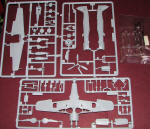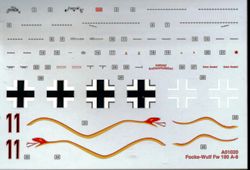
Airfix 1/72 FW-190A-8
| KIT #: | A01020 |
| PRICE: | $6.99 SRP |
| DECALS: | One option |
| REVIEWER: | Scott Van Aken |
| NOTES: | NewTool |

| HISTORY |
The Fw 190 A-8 entered production in February 1944, powered either by the standard BMW 801 D-2 or the 801Q (also known as 801TU). The 801Q/TU, with the "T" signifying a Triebwerksanlage unitized powerplant installation, was a standard 801D with improved, thicker armour on the front annular cowling, which also incorporated the oil tank, upgraded from 6 mm (.24 in) on earlier models to 10 mm (.39 in). Changes introduced in the Fw 190 A-8 also included the C3-injection Erhöhte Notleistung emergency boost system to the fighter variant of the Fw 190 A (a similar system with less power had been fitted to some earlier Jabo variants of the 190 A), raising power to 1,980 PS (1,953 hp, 1,456 kW) for a short time. The Erhöhte Notleistung system operated by spraying additional fuel into the fuel/air mix, cooling it and allowing higher boost pressures to be run, but at the cost of much higher fuel consumption. From the A-8 on, Fw 190s could be fitted with a new paddle-bladed wooden propeller, easily identified by its wide blades with curved tips. A new outwardly bulged main canopy glazing format, more in the manner of a Malcolm hood rather than a bubble canopy, with greatly improved vision sideways and forward, had been developed for the F-2 ground attack model, but was often seen fitted at random on A-8s, F-8s and G-8s. The new canopy included a larger piece of head armour which was supported by reinforced bracing and a large fairing. A new internal fuel tank with a capacity of 115 L (30 US gal) was fitted behind the cockpit, which meant that the radio equipment had to be moved forward to just behind the pilot.
Externally, a large round hatch was incorporated into the lower fuselage to enable the new tank to be installed, and the pilot's oxygen bottles were moved aft and positioned around this hatch. A fuel filler was added to the port side, below the rear canopy and a rectangular radio access hatch was added to starboard. Other changes included an ETC 501 underfuselage rack which was mounted on a lengthened carrier and moved 200 mm (8 in) further forward to help restore the centre of gravity of the aircraft. This fuselage would form the basis for all later variants of the Fw 190 and the Ta 152 series. The Morane "whip" aerial for the Y-Verfahren was fitted as standard under the port wing, just aft of the wheelwell. Nearly a dozen Rüstsätze kits were made available for the A-8, including the famous A-8/R2 and A-8/R8 Sturmbock models. The A-8/R2 replaced the outer wing 20 mm cannon with a 30 mm (1.18 in) MK 108 cannon. The A-8/R8 was similar, but fitted with heavy armour including 30 mm (1.18 in) canopy and windscreen armour and 5 mm (.2 in) cockpit armour. The A-8 was the most numerous of the Fw 190 As, with over 6,655 A-8 airframes produced from March 1944 to May 1945. A-8s were produced by at least eight factories during its lifetime.
| THE KIT |
 Hornby
continues to go through their 'replacement' phase of providing new tool kits in
place of old favorites in the Airfix catalogue. In this case the older FW-190A/F
kits are being replaced by a dedicated FW-190A-8 variant. The older kits were
not bad as things go and made into presentable models when done. Here is a link
to your editor's FW-190F.
Hornby
continues to go through their 'replacement' phase of providing new tool kits in
place of old favorites in the Airfix catalogue. In this case the older FW-190A/F
kits are being replaced by a dedicated FW-190A-8 variant. The older kits were
not bad as things go and made into presentable models when done. Here is a link
to your editor's FW-190F.
However, it is great to have a new tool 190A, especially since the currently available kits from Hasegawa and Revell AG are getting more and more expensive as time goes on. The molding on this kit is pretty much the same as on any other current Airfix new tool kit. The engravings are larger than you would find on a Hasegawa kit for instance, but still well within acceptability for the vast majority of builders.
Airfix continues to offer kits with an in-flight option and I have to say that I approve. Having a stand in the kit would be nice, but I can see why they offer it as an additional item as the majority of modelers do not put them in flight. To go with this, Airfix provides a pilot figure which is appreciated by many. Since there is a pilot, there is no seat harness either molded in place or as a decal. Frankly, I'd like to see kits offer a harness decal with their kits as it very much improves the look of the cockpit. Sure, you can get photo etch to install on the seat, but a decal would be much appreciated.
Backing up a bit, the cockpit tub looks like every 190 tub you have ever seen with the area behind the pilot attached. There is a seat, stick and rudder pedals included. There is also detail on the side consoles. Decals are provided for the main instrument panel as there is no other panel detail. A rather neat engineering detail is that the upper wings are molded as a single piece that includes the wheel well. One will have to open holes in the upper and lower wing for the fuselage rack and the gun bulges. There are inserts with the shell ejector openings for the lower wing. This leads me to believe that other variants may be kitted. Probably the 190D-9.
Exhaust stubs are provided that fit into the fuselage halves before assembly. Ther are also separate wing gun inserts. The upper cowling has two pieces one for the forward gun trough and the other the usual gun cover. I should mention that the barrels are molded in the gun cover and the pitot tube is molded into the upper wing. Good luck not breaking the pitot during construction.
Main gear looks like every other good 190 kit and it will be interesting
to see how well they lock into place as I see so many 190s built with the gear
too straight, some of mine included. Though the kit offers the 'blown' hood, it
only has the older head armor and so will be using the flat top canopy. The
bulged canopy was used starting in January 1945 construction which is after the
markings for this kit. The centerline rack is the long version and the kit comes
with a nicely done drop tank. A one-piece prop is trapped between the fan
assembly and the spinner. The instructions call for the fan assembly to be
painted RLM 74 along with the inside of the cowling. Not sure if this is
accurate. I have always felt the cowling interior was RLM 02 and the fan
assembly was black.

Instructions are well done with the usual pain of dealing with only Humbrol numbers during construction. The overall markings guide does provide proper paint names and this one is (surprise) RLM 74/75/76 in the standard and somewhat boring FW-190 paint scheme. The kit markings are for Jagdgruppe 10 with the snake along the fuselage in yellow and red. The lower cowling is in yellow. Lots of stencils and no swastika are on the nicely printed sheet. There are quite a few aftermarket sheets that have been done for the 190A-8 so finding a substitute will not be an issue if looking for something else.
| CONCLUSIONS |
I am sure this will be well recieved by the buying public. The LHS got in quite a few of them and was hoping for a lot of sales and I'm sure he will get them. I did not notice anything amiss with this kit, though I'm sure 190 enthusiasts will find it if there is anything. I happen to be a fan of the type, and since the vast majority of my 190s are in 1/72 scale, this one will be a very fun build for me.
| REFERENCES |
http://en.wikipedia.org/wiki/FW-190
Review kit courtesy of your editor
If you would like your product reviewed fairly and fairly quickly, please contact the editor or see other details in the Note to Contributors.
Back to the Previews Index Page